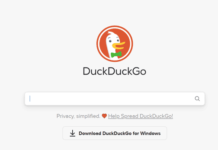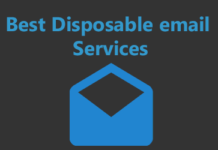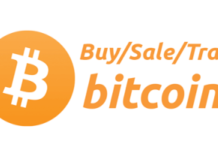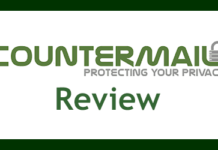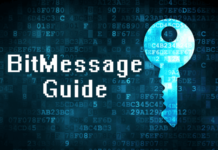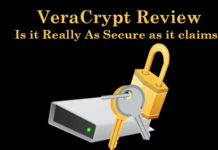The ultimate guide. I say “guide” because on top of a massive list of anonymous e-mail providers, I’ve also included additional info here.
You’ll learn how to choose the best of these services and how to strengthen your anonymity.
I’ve also included 3 different types of anonymous e-mails here. There are the fully-featured providers, the self-disposable, temporary providers, and the forwarders/aliases. (Scroll down for details).
So, even if you’re a complete newbie, you’ll be able to send 100% untraceable e-mails in the next few minutes.
The best part? Nearly all of these are 100% free, forever. Jump in then?
What are Anonymous Email Services?
I’m sure you’ve got an idea what these are. However, let me clarify these for those who’re new.
Anonymous e-mail services are mail providers which let you send and receive e-mails without revealing your real-life identity.
Any e-mail you send can be traced back to the mailbox it’s sent from. However, the mailbox can not be traced back to you. At least that’s what should happen in an ideal situation.
There are multiple ways how this is achieved. For starters, most of these providers do not collect any personal information when signing up. Meaning, you can sign up using a random name and password.
Some anonymous e-mail services also have a “no log” policy. They do not log your IP address either. Others at times may offer a Tor URL.
Some providers even take additional steps such as hiding e-mail headers or letting you encrypt e-mails before sending them.
In this piece, I’ve included 3 different types of anonymous e-mail providers. On top of the fully-featured providers, you’ll find disposable/temporary mail providers as well as anonymous e-mail forwarders!
However, do note that there are pseudo-anonymous providers as well. None of those have been included on this list yet it’s best if we discuss them briefly.
These pseudo-providers “claim” to offer an anonymous environment. However, they’d often log your IP or demand physically-identifiable information.
They say this data won’t be shared with third-party providers however you never know.
The next section will help you make better choices when choosing the best anonymous e-mail services.
How to Choose The Best Anonymous Email Services?
Over the years, I’ve worked with over a dozen different anonymous email service providers. As a result, I’ve prepared myself a checklist that’s easy to follow and gives me the best options easily.
Simply look for the following features/factors when choosing your provider and you’ll be alright:
- End-to-End encrypted: this is the first, most important and “not an optional” factor you must look for. Each provider you choose must be end-to-end encrypted. (To understand what E2E encryption is and why it’s important, please scroll to the bottom where I’ve answered some of these questions).
- No IP Logging : This is one of the most important factors you should be looking for. If the provider has a “no IP logging” policy that’s almost an instant buy signal.
- Open-source clients: You won’t always find providers which are open-source. However, it’s a plus whenever you can. Open-source clients publish their code publicly. This opens them up for an audit and lets anyone verify that their claims are true. Hence, their encryption, logging policies and a lot more becomes somewhat more transparent.
- Country of operations: The country of operations for a provider decides what laws they must abide by. Some countries force data and identity collection. We’ve only included the safer/more privacy-respecting countries on this list. However, you can get a full list of the safer countries if you scroll down.
- Tor access: Again, not the most common feature, in fact, it’s one of the rarest. However, a provider with Tor access is safer than a provider which only offers clearnet access.
- Password protected mails: On top of your login access, some providers also let you set passwords for every individual e-mail that you send. A feature that’s not very common but certainly desirable.
- Self-destructing messages: These enhance privacy and security as well, don’t they? You can either set a timer, or make it so that these burn themselves as soon as they’re read.
- Other non-privacy email features: there are a number of features which aren’t directly related to “privacy” but do make e-mailing better. E.g. Scheduled sending will let you send e-mails at a later time, on automation. Aliases would let you keep spam off while still receiving mails in your primary mailbox.
- Mobile apps: Again, not a mandatory point however it does help if the provider has dedicated apps for Android and/or iOS.
- Pricing: Almost everything on this list has a forever free plan. However, if you’ve got serious requirements, you may require a paid plan. You should also pay attention in cases where there’s a scaling probability. Your requirements may be low today but can they increase in the future? In those cases, you must look at a provider’s plans before you start using it.
How to Increase Security and Privacy on These Anonymous Email Services?
You may be getting impatient. Please bear with me. These steps are necessary if you wish to be truly anonymous.
Do note that it’s 100% possible to leak your identity and nullify any anonymity benefits if you aren’t cautious even on these providers.
What these companies offer is just one side of the story. What and how you do things while using these email services is the other side.
So, here are a few things I’ve learnt that should keep you safe-![]()
- Use a VPN: This is a must if you truly wish to be secure and anonymous. Sure, these companies say they do not keep logs, but can you truly trust them 100%? A VPN makes sure that your real IP address is hidden no matter what. With a VPN, even if the company logs your IP address, they’d not have your real IP-address. (Which is the best VPN for anonymous e-mails? Scroll down to the FAQ section).
- Only sign up after a VPN is enabled: You need security from day 1. In fact, if any provider logs your IP they’d log your sign up IP more strictly than the IP you use to connect to the site regularly. Hence, even before you click on any of these sites, make sure you’ve got the VPN. Only after enabling the VPN should you visit/ sign up at any of these sites.
- Prioritize Tor Versions: If the e-mail provider offers a Tor version, use that to sign up or use the service in the future. Tor hides your IP by default. While it’s not as good as a VPN, it’s still a lot of protection rather as compared to a clearnet connection. (Tor vs. VPN which to use? Scroll down).
- NEVER use any real-life credentials when signing up: Even on anonymous services, you’ll be asked for an username/password/hint questions for recovery etc. Never use anything that’s attached to you in your real-life. Certainly not your name, address, school name or anything else. Use random words/names that have absolutely no link to you. Even the security question should be false. E.g. if the question is “What was your first school”, use a random name and remember that.
- Use additional security features when available: Most of the options I’ve listed will offer additional security features such as 2-FA/password-protected e-mails/ self-destruct timers, and so on. These are free features. They take seconds toset upp. Do use these before sending e-mails whenever available.
- DO NOT use custom domains: Yes, you@yourdomain.com looks cool and professional but it isn’t secure. Domains can often be traced back to their owners, unless you used an anonymous domain registrar. Even in that case, it’s possible you’ve left identity breadcrumbs which can be followed back to you.
- Avoid mobile apps: Yes, sending e-mails using the mobile apps from these providers does make things easy. However, you can control less vectors on a phone than a computer. It’s best to avoid mobile apps and just use browsers on a computer to send anonymous e-mails.
- Use Brave or other privacy-respecting browsers: If you aren’t using the Tor browser, you still should switch to privacy-respecting browsers. Brave is a good option. Avoid Google Chrome / Edge / Firefox etc.
Best Anonymous Email Services
That’s about it folks. If you followed the above checklist when choosing your provider and using them, you’ll be pretty much invisible!
Private-Mail
![]() Website: https://privatemail.com/anonymous-email.php
Website: https://privatemail.com/anonymous-email.php
- Anonymous signing up
- Doesn’t log IP addresses
- End-to-End encrypted
- Self destructing Mail
- Mobile apps, WebLogin
- VPN and Encrypted File Storage
- Multiple Aliases (20+ Aliases and Identity)
- Starts at $8.95/month.
The name makes it clear why the provider is on top of this list, doesn’t it? Right off the bat, it offers some of the most desirable anonymity features.
For starters, there’s absolutely no IP logging. They’re very clear about it. Whatever you do using the e-mail account can never be legally tied to you.
*Do note that IP addresses are logged during first-purchase. This is a fraud-prevention measure. This is one of the reasons I insist on you using a VPN while signing up/using these services.
While signing up, you can use random aliases. The company doesn’t want your real name or address! Similarly, you can pay anonymously using Cryptocurrencies as well.
![]()
Then, they’ve clearly stated that they’ve “no interest in getting to know you for marketing purposes”. Unlike Gmail which used to (and maybe still does) READ e-mail contents!
This means, Private-Mail does not read your subject lines, metadata or anything else in your inbox. It’s only for your eyes.
Obviously all e-mails are End-to-End encrypted. Even with a gun to its head, Private-Mail has no way to share your e-mail, file, contacts or anything else with a third-party.
Then there are the other standard e-mail features. You get aliases, contacts, calendars etc. It does offer self-destructing e-mails for added security.
It has dedicated apps not just for Android and iOS but also desktops. Of course, you can still access it on your mobile phones.
Prices start at $8.95/month. Yes, it’s not cheap. But then, would you go for cheap, or “anonymous”?
Get Encrypted Email & Cloud Storage
Skiff – Decentralized Email Service
![]() Website: https://skiff.com/
Website: https://skiff.com/
- S-based, Free forever
- Automatic replies
- End-to-End encrypted
- Scheduled for later
- Aliases and custom domains
- Full suite for documents, files, calendar etc.
- Paid plans start at $8.00/month.
- Connect Crypto wallets and send e-mails using crypto addresses.
Get your mailbox with Skiff.com
Skiff has its ups and downs. For starters, the company is based out of U.S.A . That may be an instant no-go for a lot of you and I’d understand.
However, the company does offer End-to-End encryption. This means, despite being in the U.S, it’s technically impossible for Skiff to read or share your e-mail contents with a third-party.
Everything on your Skiff email is encrypted, this includes your calendar, links etc. Yes, it’s free to start with. You get massive 10 GB storage without having to pay anything, ever.
You do get custom domains and aliases. 4 free aliases are included on the free plan, however, custom domains are only for the premium accounts.
It’s 100% crypto-friendly. It lets you send e-mails using your ETH, Solana or addresses.
There’s also a limit of 200 emails/day on the free plan, this doesn’t happen on any of its paid plans.
A handful of advanced features do exist such as automated replies as well as scheduling e-mails to be sent later is possible. You can even “undo send” if you’re fast enough. You can also create folders and labels that help you organize files better.
Just like Google Drive, it has a full suite that offers collaborative documents, Drive, Calendar and so on. Paid plans start at $8.00.
Get Your First Decentralized Inbox With Skiff
Protonmail
![]() Website: https://proton.me
Website: https://proton.me
- Based out of Geneva, Switzerland
- No personal data needed for signing up.
- End-to-end encrypted
- Tor-access, Open-source
- No logs stored.
- Self-destructing messages
- Schedule e-mails
- Custom e-mails and aliases
- 100% free forever
Protonmail is one of the oldest and my personal favorite e-mail providers on the planet. It is one of the only e-mail providers that’s open-source and can be audited by literally anyone.
Signing up is 100% free (forever) and doesn’t require any personally identifiable data whatsoever. Protonmail is headquartered in Geneva, Switzerland and was created in 2013.
For starters, there’s End-to-end encryption. This means, literally no third-party, not even Protonmail can read your e-mails.
It also has a strict “no log” policy. This means, they do not log your IP address and hence there’s nothing that ties the account to you. It even has a Tor/Onion URL which protects your IP by default.
You can even use aliases as well as custom domains with Protonmail. On the paid plans, you even get access to Proton VPN! You can also set timers to your messages so they self-destruct after the set timer expires.
It is one of the few e-mail providers that encrypts all e-mails with Two-Step Authentication. You can even schedule e-mails to be sent at a later time.
Protonmail.com is free for up to 500 MB of storage. You can use it free, forever. With paid plans you get up to 20 GB of storage.
The ProtonMail platform is built on a modern, intuitive web and mobile interface that is designed to be easy to use and navigate. It also works with all the major web browsers (Chrome, Firefox, Safari, Edge) and mobile devices (iOS, Android).
Protonmail also has a mobile app available for both Android and iOS.
It also supports multiple languages like English, French, Spanish, Italian and German so no matter where you are located you have access to the service in your native language. All this makes ProtonMail a great choice if you’re looking for an anonymous e-mail provider!
Get Your Mailbox With Protonmail
Tutanota
Website: https://tutanota.com
- Based out of Germany, End-to-End encrypted
- Anonymous signing up, Tor version
- Aliases and custom domains
- White-labeled solution, Password protected e-mails
- Doesn’t log IP addresses, Free forever
Tutanota is on this list for more than one reasons. For starters, it’s 100% open source. Not only its e-mail clients, but also its push notification, captcha and desktop clients are open-source.
Then, it’s obviously End-to-End encrypted. It wouldn’t be on this list any other way. The contents of your e-mail are accessible only to the receiver.
The company is based out of Germany which is another privacy-loving region, far away from the U.S/U.K.
Signing up is obviously anonymous and void of personal details. You can sign up without having to reveal your name, contact number, location or any other detail.
In fact, Tutanota also has a Tor version. You can use Tor to sign up and use the e-mail which makes sure your IP address remains hidden. IP addresses aren’t logged even if you use its clearnet version though.
Some advanced features include custom domains if you need to look more professional. You can also use aliases, you get 5 of these free. Additional aliases cost extra and you get 100 aliases for EUR 4.00.
There’s also optional whitelabelling if you need that. You can add your own logo as well as a custom login URL.
It also supports autoresponders as well as e-mail templates. You can also set passwords for your individual e-mails
Tutanota is free. You can use it without having to pay and it offers 1 GB storage on the free plan. Paid plans start at EUR 1.00/month.
The best part? If you go for a paid plan, you can custom-tailor your plan. You choose then of aliases you need, storage, no. of users and other specs. Your pricing will instantly be generated based on these specs.
CounterMail
Website: https://countermail.com/
- Open-source, E2E encrypted
- Diskless drives, Masked e-mail headers
- Autoresponders, Built-in VPN
It’s obvious that CounterMail too supports End-to-End encryption, why else would I include it here, eh? It too is open-source which lets anyone verify that there are no hidden backdoors.
They don’t even use hard drives. All their servers are diskless. What this means is, there’s no data that’s permanently saved. This also means you won’t be a victim of disk failures or accidental data deletion.
Obviously 2-factor authentication can be enabled for added security. E-mail headers are automatically hidden making sure the receiver doesn’t extract data from those.
You can also set a USB key as an additional password just in case you need that added security. This is a 2-FA meaning you’d still need your password in addition to this key when enabled.
Aliases as well as custom domains can be setup. You can also set autoresponders. There is a 10-day free trial, however, it’s only available to you if you already know a paid CounterMail user.
It even has a built-in VPN which makes sure your IP address is automatically secured even if you aren’t using a VPN.
It has a few features scheduled for the near future. These include E2E encrypted chats, scheduled messages, auto-burn messages after being read etc.
Tormail
Website: https://tormail.io/
- No IP-logging
- Tor version available
- Encrypted
- Sweden & Switzerland jurisdictions
- Not free.
I’ll be honest, Tormail isn’t the most feature-rich option here. However, it too is a service that provides anonymous e-mails.
The site very clearly states that they do not maintain logs of any kind. Then, there’s a Tor version which adds to your anonymity.
The servers are based in Sweden as well as Switzerland. These are some of the most desirable locations as I’ve also mentioned in the safe-countries list later in this guide.
There’s PGP encryption which makes sure your e-mail remains secure and untouchable.
There are no free plans, however, the plans are affordable. You can either choose to pay annually, bi-annually or go for the one-time lifetime plan. The lifetime plan costs $179.00 once and you never pay again. The annual plan is charged at EUR 59.00.
Self-Disposable or Temporary Anonymous Email Services
So far, I listed the fully-featured anonymous e-mail services. However, there’s a different breed to these as well.
Temporary anonymous e-mail services are services which let you create disposable e-mail accounts.
These e-mails aren’t meant to serve as your primary e-mails. Rather, they’re mostly a one-time thing or at best for a few days.
You can use these to expose corruption, leak information to the media etc. These are also perfect for other one-time activities such as downloading e-books.
Most of these are simpler to use and in some cases do not even require signing up/registrations.
Do note that at times these services may allow either only sending, or receiving of e-mails.
Technically, these are actually more anonymous (With a VPN + Tor Browser) than the fully-featured providers we’ve listed above. Of course, these lack some other advanced mailing features but if it’s “anonymity” you need, these are perfect.
*You must use a VPN with these services. Most of these do log your IP address.
Here are your best options.
Guerrillamail (Send and receive mails)
Website: https://www.guerrillamail.com/
- 100% free, No registration
- Optional and free scrambled addresses
- File attachments allowed: 150 MB
- 1-hour mail retention
This is one of the oldest and most popular disposable and anonymity-respecting e-mail services out there. As soon as you land on the site, an e-mail is instantly assigned to you.
You can change it manually to anything you want. You can also choose from over 10 different domain extensions!
![]()
Do note that there are no “passwords”. This means, your e-mail ID also is your password. Anyone with access to your e-mail ID can access your e-mails.
However, you may use a “scrambled address”. It’s a free feature and only requires a single click. This generates a more complicated address for you which will be hard to remember/recognize for your receivers.
E-mails are automatically and permanently deleted after one hour.
Anonymousemail (Send only)
Website: https://anonymousemail.me/
- No registration, No inbox (can not receive e-mails)
- Free + paid versions
- Track e-mail opening, Limited free features
Another temporary e-mail provider that lets you send anonymous e-mails without registration! Do note that you do not get to define the “sender’s” e-mail ID if you’re a free user.
You arrive on the site, enter a receiver’s mail ID/your subject line/ e-mail content and done. Attachments are supported but only for premium members.
You can also track when your e-mails are opened but this requires an additional e-mail ID and is a paid feature.
You can not receive e-mails on Anonymousemail. However, you can set a “reply-to” address (forwarded address) if you’re a paid user.
Do note that Anonymousemail is a “send-only” service. You can not use it to receive e-mails (unless you use a reply-to mail and a different provider to receive mails).
Temp-mail (Receive only)
Website: https://temp-mail.org/
- No registration, 100% free
- Change unlimited e-mail IDs
- Can only receive-emails.
The name makes it pretty evident that Temp-mail is a “temporary e-mail”, doesn’t it?
Again, no registration is needed to use Temp-mail. As soon as you visit the website, you instantly get an e-mail ID assigned to you. You can click on the “change mail” button to instantly burn this ID and receive a new one.
Simply share this with anyone you’d like to receive e-mails from. E-mails are valid for as long as you do not manually delete them, or change them.
5ymail (send and receive)
Website: https://www.5ymail.com/
- Send and receive e-mails
- No mandatory registrations
- Track email opening *
- Customized name and sender e-mail*
- Attachments allowed *
- Schedule emails *
- Free & paid plans
*Star-marked features require payment.
If you need a professional interface, you’ll be disappointed. 5ymail is pretty cluttered and is spammed to death by ads. However, if all you care about is anonymous e-mails, it gets the job done.
Now, in terms of features, it does let you set a “name” for free. However, the “sender’s email” can only be changed if you’re a paid user.
It does allow receiving e-mails and file attachments for paid users as well. You can also scheduled mails (paid, again).
Free accounts can send 100 emails/day. It can both send and receive emails. You can also use it as an e-mail forwarder on the paid plan.
Sendemail
Website: http://sendemail.in/
- Logs IP address, No registration required
- Customized name/sender’s email
- 100% free
This is an extremely straight-forward anonymous mailer. It can only be used to send e-mails. You simply enter your name, a sender’s e-mail ID, receiver’s’ ID, a subject and mail content.
There are no other fancy bells and whistles. No account registration is required and there’s no inbox. You can not undo/revisit the mails once they’re sent.
The service is 100% free and does log your IP address. In my experience, the delivery-rate isn’t great though.
Anonymous Email Aliases and Forwarders
These are another kind of anonymous e-mail accounts you can own. These are different in the sense that the primary purpose here is “e-mail forwarding” rather than sending e-mails.
Meaning, you get an alias/fake e-mail ID. You link this e-mail ID to your real e-mail ID. Now, you can use your fake e-mail anywhere you want, without revealing your real e-mail.
![]()
You can use it to sign up at services, identify which service sold your data, hide in mass databases etc.
Receivers reply to alias/fake-email without ever seeing your real e-mail. Some services do have their own inboxes so you need not forward all e-mails to your real e-mail, however that’s not always the case.
Do note that these may not be End-to-End encrypted.
SimpleLogin
Website: https://simplelogin.io/
- Europe jurisdiction
- 100% free forever
- Wildcard aliases, Custom and subdomains
- PGP encryption
SimpleLogin is an anonymous e-mail alias provider that’s free forever. You get 10 aliases and an inbox for free. This means, you can receive emails as well and it’s not just for senders.
There’s no cap on the number of mails you can send either.
Paid plans have additional features such as subdomains, PGP encryption etc. You can also attach custom domains. Paid plans also offer wildcard aliases (anything@alias.com).
Paid plans start at 44.00/month.
AnonAddy
Website: https://anonaddy.com/
- Custom domains, 5 different alias extensions
- On-the-fly aliases, Very professional and easy-to-use UI
- Browser extensions, PGP encryption
- Free forever
AnonAddy is similar to SimpleLogin in terms of the core-feature. You can create multiple aliases and forward them to your real/primary mail account.
Over 5 different domain extensions are available to choose from. AnonAddy does require registration. It also keeps server access logs even though your e-mail contents are safe.
It does allow on-the-fly alias creation. If you’ve added your custom domain on AnonAddy, you can enter anything@yourdomain.anonaddy.com to use the alias instantly.
It also offers browser extensions. It also lets you add your own PGP encryption for each recipient. Has one of the best interfaces. Toggling aliases/encryption on/off is a one-click task.
There’s a forever free plan. Paid plans start at a low $1.00/month.
Frequently Asked Questions (FAQ)
I’ve used terms and words here that may not always make sense to you. Even if they do, you aren’t sure why these things are required or how they help you.
So, here are answers to a few questions that should help you be more anonymous when sending e-mails:
What is End-to-End encryption?
Technically, it’s quite complex. However, I’ll keep it simple. It’s an encryption algorithm which makes sure your e-mails are encrypted from your end, to the receiver’s end. There’s no way any person or entity, no matter how powerful, can intercept the contents of this mail mid-way. To decrypt the contents, they must have either your or the receiver’s login credentials.
Is it illegal to use anonymous e-mail service?
No, it’s not. Obviously, sending illegal e-mails, participating in fraud or engaging in any illegal activity is still illegal even if you use anonymous e-mail services.
Can I be tracked if I use anonymous e-mail services?
It depends on a number of factors. To be 100% anonymous, you must comply with a few rules. If the e-mail service is E2E encrypted and you used a VPN AND TOR when signing up/using the service, you’re safe.
How does TOR help protect your identity?
TOR routes all your connections via the onion network. In simpler words, your IP address is changed automatically when you use Tor browser. Hence, even if your provider is logging IP addresses, it doesn’t receive your real IP address.
Additionally, TOR also masks your digital fingerprints such as screen size, pixels, resolutions etc.
TOR vs.VPN which is better for anonymous e-mails?
It isn’t a competition, rather a collaboration. Meaning, you’re most secure if you use both VPN and Tor browser. If you must use only one, go with a VPN. TOR offers less features and does have a chance of being tracked back to you.
Which is the best VPN for these e-mail services?
NordVPN is the best e-mail for sending anonymous e-mails. Its “no log” policy has been independently verified and it’s Tor-friendly.
It also has advanced features such as “Double VPN”. This changes your IP twice, couple that with Tor’s routing and you’ll be invisible.
| NordVPN | Surfshark VPN | AtlasVPN | ExpressVPN | TorGuard VPN |
|---|---|---|---|---|
1. NordVPN | 2. SurfShark VPN | 3. AtlasVPN | 4. ExpressVPN | 5. TorGuard |
Which are the best jurisdictions to choose from for anonymous e-mails?
Switzerland, Panama, Netherlands, Norway, Romania, Bulgaria are some of the best options.
Final Words
With over 14 encrypted and untraceable e-mail options on this list, I do hope you found what you were looking for?
Do note that these services are only as anonymous as you let them be. Unless you make sure you aren’t leaking identity on your end, you aren’t 100% safe.
The best way to ensure 100% anonymity? Download a VPN > launch the VPN and connect to a foreign IP > download Tor browser > sign up at the email provider. While signing up, make sure you aren’t entering any real-life data whatsoever.
That’d be all for now. I’ll recommend starting with Private-Mail; if you need a free anonymous e-mail provide Protonmail is a good option.
